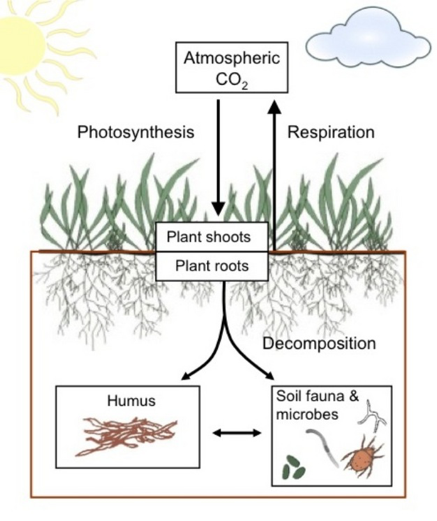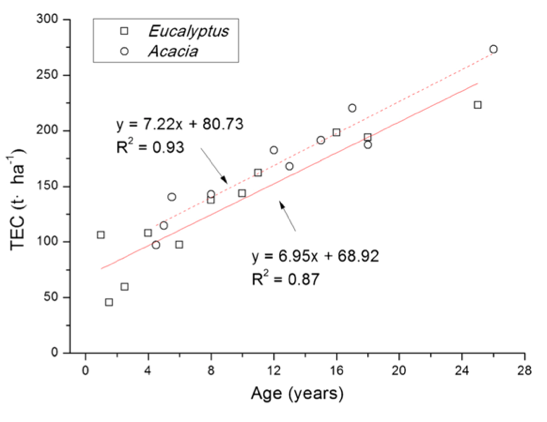|
Notes:
1. This is an update to the original as published in the MPLN Newsletter of March 2020.
2. The assessment of carbon sequestration by vegetation is an imprecise area so this will not necessarily match the values assumed by the Government carbon credit scheme.
The write-ups for both the Linking the Mornington Peninsula vision and each of its daughter biolink initiatives quite correctly

focus on the benefits to local ecosystems and particularly to the free movement of plants and animals between what would otherwise be disconnected and endangered patches of residual native systems.
But perhaps biolinks also have an important role in reducing our net CO2 emissions?
Let us first consider what happens when a new forest is established and a whole new ecological process kicks in, as shown in the figure (Todd 2012).
Photosynthesis extracts CO2 from the air initially to build trunks, branches, leaves, and roots of the new plants. Then, as the forest develops the interactions become more complex: tree roots pass carbon-rich sugars to underground fungi and similar; leaf litter builds up on the forest floor and uncountable numbers of detritivores move in to feast on the plenty. In a mature forest there may be ten thousand or more of these tiny creatures per square metre.
Lerps, caterpillars, beetles and general bugs gobble up leaves or bore into the bark and wood.
These tiny creatures in turn provide a food base for a range of carnivores, scavengers and the detritivores that feed on their dead bodies and faeces (see Bennet 2016 for an excellent overview of how forested areas work to support entire communities).
In addition to helping maintain a viable ecosystem, all this animal and fungus activity releases some of the sequestered CO2 to the atmosphere through respiration. Plants also release a range of volatile organic compounds containing carbon, and return CO2 to the atmosphere by respiration during the night.
But, detritivores and fungi also turn part of the litter into dark humus – for example, fungi consume the cellulose, or lignan in the wood, and leave the carbon. The resulting humus is a rich contributor to healthy soils and a stable store of carbon. An additional large mass of carbon is stored in the trunks and branches.
Much of the stored carbon from all processes eventually may decay back to atmospheric CO2 but this takes decades to centuries to occur – in wetland areas the anaerobic conditions mean that the carbon is locked up for very long periods.
Because of all this complexity, the carbon storage cycle is quite complex, and the details are not well understood. Lack of full understanding has generated considerable scientific discussion on how much atmospheric CO2 is actually removed by forests (see Popkin 2019 for a good review). Here we bypass this uncertainty and take the pragmatic approach of simply using the long-term record of the carbon actually stored by a growing forest based on the Zhang et al 2018 multi-year observations from developing eucalypt and acacia forests in the Pearl River Delta of China (see figure).

The Delta is located just inland from Hong Kong at a latitude of 22-23oLatitude. This is more tropical than our location of around 38o south and thus may only provide an indicator of the carbon sequestration by our biolink activities. However, the numbers are similar to those from other Australia studies and we are using the conservative values from just the growing eucalypts. Acacias sequester slightly more carbon thanks to their ability to fix atmospheric nitrogen into the soil and other Australian studies have found that a mixture of eucalypts and acacias does the best job of sequestration.
The nearly-completed first phase of the Greens Bush to Arthurs Seat Biolink (GB2AS) added 27,5000 native plants over a total area of 25.9 Ha and 27,500 plants and 26 properties. Even if only 50% survive, these will provide a solid overstory canopy accompanied by a varied mix of lower acacias and other plants – in other words an ideal mix for sequestering carbon.
Using the above graph the growing biolink bush can be expected to sequester ~7 t/Ha/year of carbon and thus sequesters ~26 t/Ha/year of atmospheric CO2.
Thus, our current ~26 Ha GB2AS Biolink section is removing ~680 tonnes of carbon dioxide semi-permanently from the air each year.
This is ten times the carbon storage capacity of the pasture that they replaced (Chief Scientist 2009).
To put this benefit in a local context, 680 t/year of CO2 removal:
- Provides an emissions compensation of over 1 t/year for each of the 700-odd volunteers who helped in the biolink design and implementation
- Alternatively, 26 t/year could be claimed by each of the 26 properties involved, making their residents approximately carbon neutral, and where larger plantings have been made additional income through carbon credits may be available.
When the full GB2AS Biolink is finished, it is reasonable to expect that at least 100 Ha of new bush will have been developed – then we shall be removing ~2600 t/year of CO2 from our atmosphere. Provided this bush is protected, over 260,000 tonnes will be sequestered over a century.
Do we dare to dream of what could really be done if we all worked together on implementing a coordinated biodiversity program for the Shire and beyond. A program that supports extensive biolinks and stable ecosystems with their resident populations of native wildlife. A program that leads to zero net CO2 emissions across the region while improving lifestyles. A program from which agriculture, tourism, and residents all benefit. And a program that could set a shining example for the rest of the country.
Perhaps our biggest hurdle lies with us daring to dare.
– Article by Greg Holland with thanks to all those who have contributed to the success of the biolink program. |